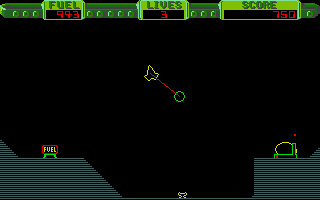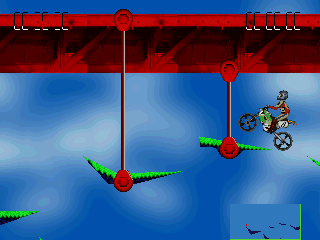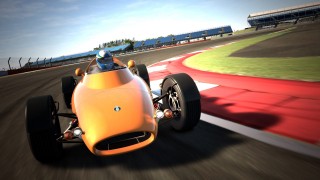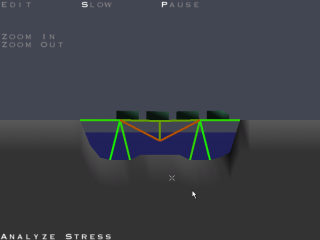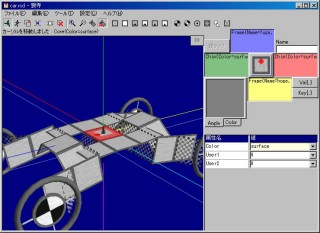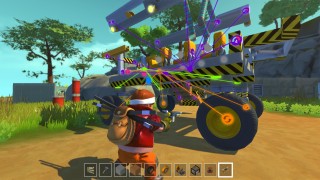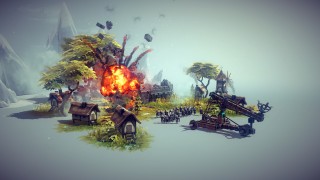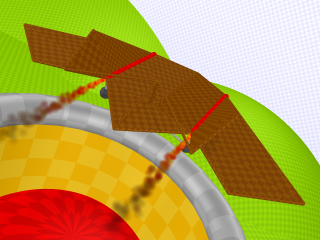
Featured Blog | This community-written post highlights the best of what the game industry has to offer. Read more like it on the Game Developer Blogs.
Why I love physics-based games
An exploration of how and why physics can provide enduringly fun gameplay.

Why I love physics-based games
I've always loved games based around physics, and my two games (Armadillo Run and Lucifer's Atoms) both have gameplay heavily reliant on the magic of simulating real-world mechanics.
Lucifer's Atoms has taken me over six years to develop. But even though I've played with it so much over that time, I'm not bored with it – I'm still drawn back to make new things and play around with them. Why is that? I think it's because of the wonderful match of the rules of physics to the nature of play.
What is play?
Play is interactive experimental learning. You take some action, see the result, maybe learn something from it, and repeat until you have full knowledge of the system you're investigating. Then you're bored with it. If you play with a cat, making the movement of the toy unpredictable will keep their interest longer – as soon as they know what will happen, it's not so fun any more.
So if play is the exploration of the possibilities in a play space, then to make a fun game we need to make that play space large enough. But there are other factors apart from size alone. Things like local continuity and internal consistency are required to make exploring the play space satisfying.
The properties of physics
Physics has simple rules …
Things keep moving at the same speed and in the same direction (constant velocity), unless a force acts on them.
When a force happens, it's actually two forces (equal magnitudes, opposite directions) acting on two objects.
A force affects the velocity of an object. The change in its velocity is inversely proportional to its mass.
There's some other things too, like how objects interact when they collide, touch (solid-solid friction) or move through each other (solid-gas/liquid friction). But if that's it, how is physics interesting? From what I've written above, you might think people would learn these rules pretty quickly and then get bored. Or worse – they already know them from experience, so they'd be bored of playing a game based on them before they even start.
… from which springs endless complexity …
The real world around us is rich in interesting behaviour. Insects, birds and bats independently developed their own different methods of flight. Insect flight in particular is quite interesting – look up "clap and fling". And yet it all follows from those simple underlying physics rules.
A simple example. The motion of a pendulum is so predictable that it was the standard way to measure time for over 250 years. But put a second pendulum on the bottom of it and it's not so predictable any more.
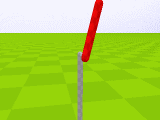 Single pendulum
Single pendulum
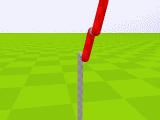 Double pendulum
Double pendulum
… which is well-suited to play
This concept of complexity emerging from simple rules is well known in game design, and is often sought out by designers. Simple rules help make a game accessible to new players, and complex emergent behaviour allows for a deep array of choices. If a game can capture some of the rich behaviour we see around us in the real world, it can provide a virtual world with a large play space that's satisfying to explore. In a word, fun.
Going back to the nature analogy, should you choose to walk on 2 legs or 4? 6 is really the minimal stable number. But 8 lets you be stable and dextrous at the same time. What about 0? There are many examples of each of these in nature – and more. There is no global best choice, just degrees of goodness for certain situations. Sounds familiar? It's a description of good game design!
Types of physics-based games
Gravity
One of the earliest examples of physics-based gameplay, Thrust requires forward planning for movement because:
The relatively high ship momentum compared to the player control force limits acceleration.
The tank control scheme gives a further layer of detachment from player input, preventing instantaneous changes in direction.
The tractor beam feature requires players to also plan for the behaviour of the large mass that they must tow, which is free to swing around the ship. The position and velocity of the towed mass also affects the effect of the player control force.
Here, physics is being used to make the controls more remote. The play space being explored is developing player prediction of the second-order equations describing the system. You're learning integration by intuition.
Vehicle control
For these motorbike games, the challenge is to build a mental model of how the player control force affects both the positional and rotational acceleration of the bike. Like a Rubik's cube, they're both tied together – you can't change only one of these at a time. The position of the rider's weight and the current slope angle are further factors that determine the position/rotation acceleration split.
At their core, all driving games are about car handling – the interaction between the tyres and road. Such a small physics element, but one that has enough richness to maintain interest in the driving game genre (although maybe I wrongly attribute player interest to the driving physics rather than extraneous things like collection mechanics and brand association). Gran Turismo was the first game that I'm aware of that modelled the effect of weight transfer on grip, and thus car handling. Developing a feel or skill for driving at the limit of grip is I think better described as having learnt a mental model of the weight-grip relation.
Body control
Ski Stunt Simulator is a beautiful game. Controlling only the body posture of a man on skis, you have to ski down a hill without crashing, and also perform forward and back flips. As with Thrust, Elasto Mania, and Trials, you can't do these things immediately – you have to build them from a sequence of player inputs, planning ahead.
Because the game uses a continuous input source (the mouse), it allows small variations in input. So you can launch off a jump into a roll, without knowing exactly how it will work out (will I spin 2 or 3 times?), and then when you see how it's progressing, you can make small adjustments to crouch (spin faster) or straighten (spin slower) to make sure you land on your feet. This control finesse makes you feel connected and you can start to play with flair and expression. Rare words to describe a game, but the kind of words people sometimes use to describe the way someone with great skill plays a real-world physics game like football (soccer to Americans).
Construction/design
Instead of having a single hard-coded physics object for players to interact with, these games let players define their own physics objects as compounds of atomic primitives. So now the challenge is a higher-level one – instead of learning a deep understanding of the behaviour of a single system, players are exploring the behaviour of all the systems that can be constructed from the available primitives. With careful choice of the primitives, a large and rich play space can be created.
Game designers lose some control when they give players such freedom, but they gain a large internally-consistent play space for players to explore and find their own solutions to a game's challenges, rather than just one that the designer envisioned.
Letting players control their creations is the obvious development of this type of game. These games make different choices for their available primitives and combination options, but all of them have a play space that's interesting to explore, largely or wholly due to the bountiful complexity thrown out by the interaction of a few simple rules. <pun>Physics rules.</pun>
Conclusion
Interesting complexity can arise from simple physics rules, which naturally suits play. This can be utilised by defining an interesting object (as in the gravity, vehicle control, and body control game types above) or allowing players to define the objects (as in the construction/design type).
Maybe a future game could ask players to define the physics rules or constants?
Screenshots from MobyGames
Read more about:
Featured BlogsAbout the Author(s)
You May Also Like

